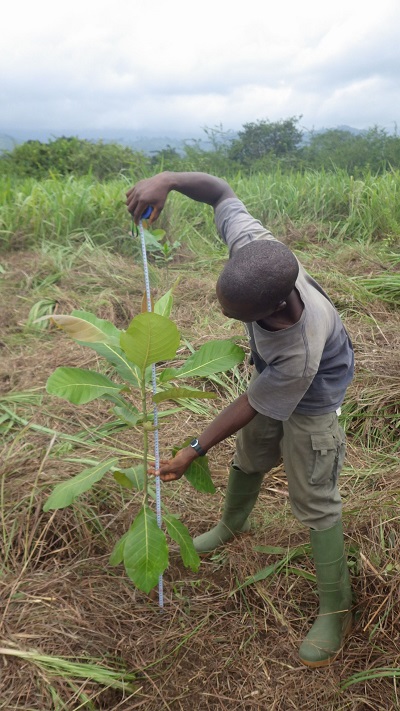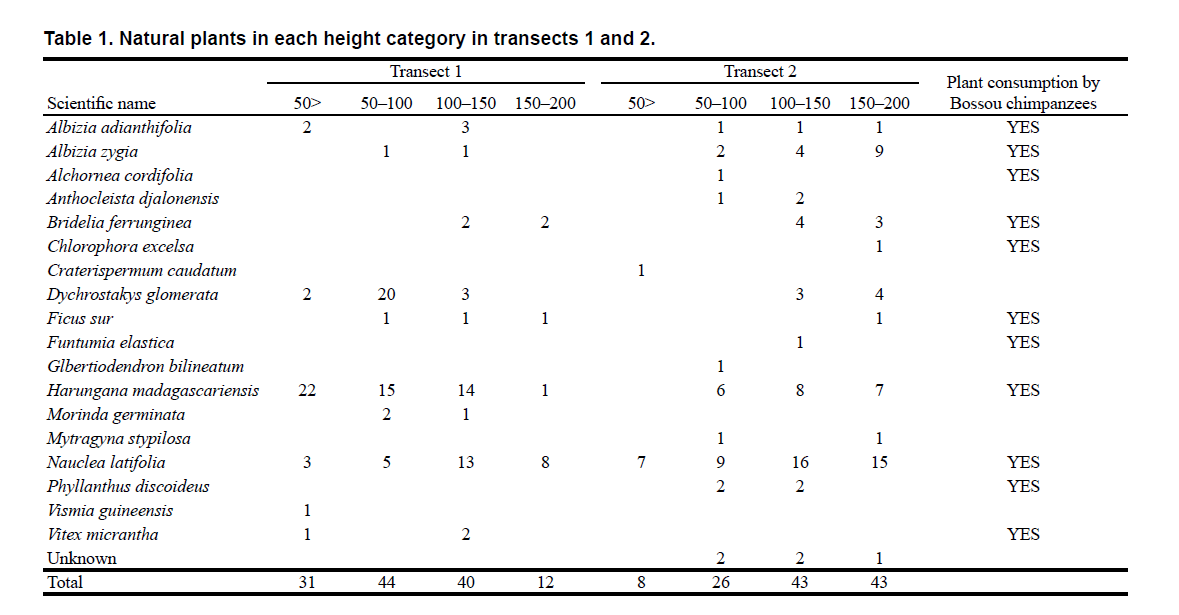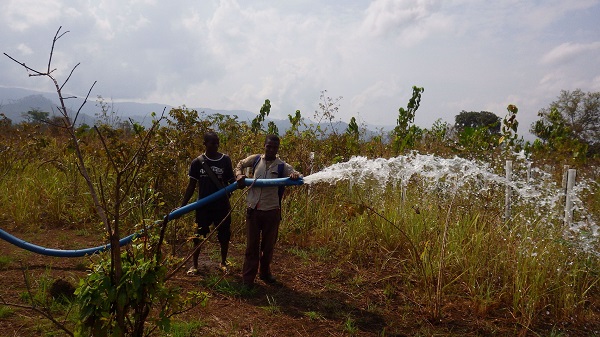|
<NEWS>
A survey of the savanna vegetation in Bossou, Guinea
Naruki Morimura1, Gaku Ohashi2 & Tetsuro Matsuzawa3
1 Wildlife Research Center, Kyoto University, Japan 2 Japan Monkey Centre, Japan 3 Primate Research Institute, Kyoto University, Japan At Bossou, located 4 km west of the Nimba Mountains representing the only World Natural Heritage site (UNESCO⁄MAB) in Guinea, a group of chimpanzees has been studied for the past 39 years (Matsuzawa et al. 2011). The Bossou chimpanzees, which currently number nine individuals, have coexisted over many generations with the local Manon people in the village. Due to the lack of female immigration since the beginning of the field study and a flu–like epidemic (Matsuzawa et al. 2004) that occurred in November 2003, this isolated local population is in ongoing danger of extinction. The Green Corridor project (Hirata et al. 1998), a tree plantation effort in the savanna, was started in 1997 to promote individual interchanges between the wild chimpanzee groups at Bossou and the Nimba Mountains. We developed the arbor procedure (Ohashi et al. 2008) at a sapling nursery in the savanna using chimpanzee feces after struggling to protect fragile saplings in the savanna with HEXATUBEs (Phytoculture Control Co., Ltd.). The arbor procedure provides saplings with similar conditions to those of the nursery after transplantation to the savanna. We had constructed 47 arbors for plantings by 2012. The arbor procedure is well suited for promoting plant growth in the savanna to greater than 4 m in height. In brief, the procedure involves the following steps: (1) growing Uapaca heudelotii saplings in chimpanzee feces (Matsuzawa 2007), (2) planting the saplings under arbors in the savanna during the rainy season, and (3) cutting the grass in the area surrounding the grown saplings to protect them from bush fires, especially during the dry season. Theoretically, regular use of the arbor procedure will construct a plantation corridor connecting the forests of Bossou and the Nimba Mountains. Currently, we must refine a strategy for connecting each arbor to create this tree plantation corridor. The trees grown in a plantation can provide similar condition as the arbor by shadowing over the new natural and⁄or artificial saplings that surround rotten arbors during strong sunshine. Expanded grass cutting is expected to maintain these saplings by facilitating sapling growth in the rainy season and increasing the resistance of the plantation to bush fires in the dry season (Morimura et al. 2011). We place plantation arbors only where necessary, in places where saplings cannot grow naturally. The combination of arbor sapling plantation and grass cutting may allow us to extend the plantation area into a belt over 1 km in length while controlling the labor force and financial costs. We began cutting the grass between the plantation points at current and former arbors to create plantation strip areas in January 2014. It is unclear ,however, what plant species can grow naturally in the savanna around Bossou, which is dominated by elephant grass. Moreover, no information is available on whether grass cutting facilitates the growth of small natural saplings that are under the bush. Therefore, we conducted vegetation surveys at two transects soon after grass cutting between July and August 2014. In the first transect (#1), the grass had been cut in January 2014. The elephant grass had subsequently grown up and dominated the area again by the time of the survey. In the second transect (#2), the grass had been cut for the first time at the time of the present survey. The lengths of transects 1 and 2 were 581 m (from 7°38'2.16''N⁄8°28'51.12''W to 7°38'12.87''N⁄8°29'4.42''W) and 524 m (f rom 7°37'59.8''N⁄8°28'51.54''W to 7°38'11.39''N⁄8°29'6.54''W ), respectively, and the width of each was approximately 10 m. NM and local assistants identified the scientific names of all natural tree species below a height of 2 m and measured their heights (Figure 1). 
We counted 127 and 120 natural plants in transects 1 and 2, respectively (Table 1). A total of 18 plant species were identified, and five plants were categorized as unknown. Seven species grew in both transects. Of the 18 species, 11 were included on the plant food list of the Bossou chimpanzees (Matsuzawa et al. 2011). We categorized the plant heights into the following four classes: <50, 50–100, 100–150, and 150–200 cm. The number of saplings between the two transects was significantly different for each height class except for 100–150 cm (Mann-Whitney U-test, U = 761.0, Z = 0.93, p = 0.35). In transect 1, the less recently cut area, the numbers of plants were larger than in transect 2 for the <50 and 50–100 cm classes (<50 cm class: U-test, U = 22.0, Z = 3.95, p < 0.01; 50–100 cm class: U = 167.5, Z = 5.04, p < 0.01). In contrast, the number of plants in transect 1 was smaller than that in transect 2 for the 150–200 cm class (U = 126.0, Z = 2.74, p < 0.01). Thus, transect 1 was more enriched with small natural saplings compared to transect 2. 
The findings of the vegetation surveys indicated that grass cutting was effective for enhancing the growth of natural saplings, because (1) few different plant species can survive naturally in the bush, (2) new natural saplings can emerge after mowing, and (3) the natural plant species in the transects mostly consisted of various food plants of the Bossou chimpanzees. A number of new natural saplings in transect 1 compared to transect 2 can be expected to become a possible food resources of fruing trees for wild chimpanzees in the future, while most of them were too young to produce fruits at the moment. Therefore, the combination of arbor sapling plantation and grass cutting around the plants was effective, not only for improving the working efficiency of the labor force and reducing financial costs, but also for practicing reforestation by providing natural food and space resources for wild chimpanzees. Further studies on the survival of saplings at different height classes are necessary, as the present survey observed fewer tall natural saplings in transect 1 than in transect 2. We plan to plant 20,000 saplings of Uapaca heudelotii in the area of the two transects in 2015. This planting is expected to illustrate the effectiveness of our combined procedure by creating plantation strips greater than 1 km in length. Additionally, in 2014, we started a pilot study on watering the grass-cutting area during the dry season with an engine-driven water pump (Figure 2). Our empirically grounded techniques for plantations have substantially accelerated the progress of the Green Corridor project. Unfortunately, an epidemic of Ebola virus disease (EVD) is ongoing in Guinea, Liberia, Sierra Leone, and other countries (Butler & Morello 2014). Two patients with EVD were confirmed in Lola, a town located approximately 18 km from Bossou, in September 2014. Despite these circumstances, all local collaborators that have worked for the Green Corridor project remain in good health. 
ACKNOWLEDGEMENTS This work was financially supported by grants from the Toyota Environmental Activities Grant Program by the Toyota Motor Corporation (G2013-036), MEXT KAKENHI (#24000001), and the JSPS Core-to-Core Program, A. Advanced Research Networks to Tetsuro Matsuzawa. Thanks are also due to the Guinean authorities, Dr. Aly Gaspard Soumah from the Institut de Recherche Environnementale de Bossou, and Dr. Mohamed Salou Diane from the Direction Nationale de la Recherche Scientifique et Technologique. We thank our coworkers, including Bouna Zogbila, Remy Touré, Diri Bamba, Boniface Zogbila, Jiles Doré, Henry Camara, Gouanou Zogbila, Vincent Traoré, and Lawé Goweibé, for their support of the project. We are also grateful for Drs. Yukimaru Sugiyama and Gen Yamakoshi, who contributed to this project during various stages. REFERENCES Butler D, Morello L 2014. Ebola by the numbers: The size, spread and cost of an outbreak. Nature 514:284–285. Hirata S, Morimura N, Matsuzawa T 1998. Green passage plan (tree-planting project) and environmental education using documentary videos at Bossou: a progress report. Pan Afr News 5:18–20. Matsuzawa T 2007. Assessment of the planted trees in Green Corridor Project. Pan Afr News 14:27–29. Matsuzawa T, Humle T, Koops K, Biro D, Hayashi M, Sousa C, Mizuno Y, Kato A, Yamakoshi G, Ohashi G, Sugiyama Y, Kourouma M 2004. Wild chimpanzees at Bossou- Nimba: deaths through a flu–like epidemic in 2003 and the green–corridor project. Primate Res 20:45–55, in Japanese with English summary. Matsuzawa T, Humle T, Sugiyama Y 2011. The Chimpanzees of Bossou and Nimba. Springer Verlag, Tokyo. Morimura N, Ohashi G, Soumah G, Matsuzawa T 2011. Bush fire control using arbors in green corridor project at Bossou. Pan Afr News 18:10–11. Ohashi G, Hasegawa R, Kourouma M, Matsuzawa T 2008. Arbors and cuttings: new trials for green corridor project at Bossou-Nimba. Pan Afr News 15:20–23. Back to Contents |